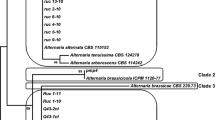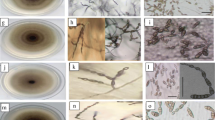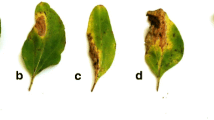Abstract
Species of Alternaria are serious plant pathogens, causing major losses on a wide range of crops. Leaf blight symptoms were observed on tomato leaves, and samples were collected from various regions. Isolation was done from symptomatic tomato leaves, and 15 representatives were selected from a collection of 65 isolates of Alternaria species. The virulence of Alternaria isolates was investigated on detached leaves (DL) and whole plants of tomato cv. Super strain B. A phylogenetic analysis was performed based on three partial gene regions, the glyceraldehyde-3-phosphate dehydrogenase (GAPDH), the RNA polymerase second largest subunit (RPB2) and the Alternaria major allergen gene (Alt a 1). The potentiality of Alternaria isolates to produce toxins was also investigated on the basis of thin-layer chromatography (TLC). Our investigations revealed that Alternaria isolates showed different levels of virulence either on tomato plants or DL. Based on the phylogeny of three genes, Alternaria isolates encompassed two species of small-spored morphospecies: A. alternata (14 isolates) and A. arborescens (single isolate). The produced toxins varied among Alternaria isolates with tenuazonic acid (TeA) being the most abundant mycotoxin produced by most isolates. This study highlighted on other Alternaria species in Egypt that might represent a serious concern for tomato producers as causal agents of leaf blight over other species, i.e. A. solani.





Similar content being viewed by others
References
Akhtar KP, Saleem MY, Asghar M, Haq MA (2004) New report of Alternaria alternata causing leaf blight of tomato in Pakistan. Plant Pathol 53:816. https://doi.org/10.1111/j.1365-3059.2004.01099.x
Andersen B, Krøger E, Roberts RG (2001) Chemical and morphological segregation of Alternaria alternata, A. gaisen and A. longipes. Mycol Res 105:291–299
Andrew M, Peever TL, Pryor BM (2009) An expanded multilocus phylogeny does not resolve species among the small-spored Alternaria species complex. Mycologia 101:95–109
Berbee ML, Pirseyedi M, Hubbard S (1999) Cochliobolus phylogenetics and the origin of known, highly virulent pathogens, inferred from ITS and glyceraldehyde-3-phosphate dehydrogenase gene sequences. Mycologia 91:964–977
Bessadat N, Simoneau P, Benichou S, Setti B, Kihal M, Henni JE (2014) Morphological, physiological and pathogenic variability of small-spore Alternaria causing leaf blight of Solanaceae in Algeria. Afr J Microbiol Res 8:3422–3434
Betina V (1993) Chromatography of mycotoins techniques and applications. J Chromatogr Libr 54:455
Bottalico A, Logrieco A (1998) Toxigenic Alternaria species of economic importance. In: Sinha KK, Bhatnager D (eds) Mycotoxins in agriculture and food safety. Marcel Dekker, New York, pp 65–108
Caldas ED, Jones AD, Ward B, Winter CK, Gilchrist DG (1994) Structural characterization of three new AAL toxins produced by Alternaria alternata f. sp. lycopersici. J Agric Food Chem 42:327–333
Cotty PJ, Misaghi IJ (1984) Zinniol production by Alternaria species. Phytopathol 74:785–788
Crous PW, Verkley GJM, Groenewald JZ, Samson RA (eds) (2009) Fungal biodiversity. CBS laboratory Manual Series 1. CBS-KNAW Fungal Biodiversity Centre, Utrecht
Cutler HG, Parker SR, Ross SA, Crumley FG, Schreiner PR (1996) Homobotcinolide: a biologically active natural homolog of botcinolide from Botrytis cinerea. Biosci Biotechnol Biochem 60:656–658
Devi PS et al (2010) Isolation and characterization of alternariol and alternariol monomethyl ether produced by Alternaria alternata of groundnut. Bioscan 5:323–330
Droby S, Dinoor A, Prusky D, Barkai-Golan R (1984) Pathogenicity of Alternaria alternata on potato in Israel. Plant Dis 74:537–542
Fan ZY, Wang WQ, Meng RJ, Han XY, Zhang XF, Ma ZQ (2013) Identification of the pathogens of potato early blight and their sensitivity to different fungicides. Acta Phytopathol Sin 43:69–74
Fernández-Cruz ML, Mansilla ML, Tadeo JL (2010) Mycotoxins in fruits and their processed products: analysis, occurrence and health implications. J Adv Res 1:113–122
Foolad MR, Ntahimpera N, Christ BJ, Lin GY (2000) Comparison of field, greenhouse, and detached-leaflet evaluations of tomato germ plasm for early blight resistance. Plant Dis 84:967–972
Garganese F, Schena L, Siciliano I, Prigigallo MI, Spadaro D, De Grassi A, Ippolito A, Sanzani SM (2016) Characterization of citrus-associate Alternaria species in Mediterranean areas. PLoS One 11:1–18
Gherbawy Y, Hussein MA, Runge F, Spring O (2018) Molecular characterization of Alternaria alternata population isolated from Upper Egyptian tomato fruits. J Phytopathol 1–13. https://doi.org/10.1111/jph.12752
Grogan RG, Kimble KA, Misaghi I (1975) A stem canker disease of tomato caused by Alternaria alternata f. sp. lycopersici. Phytopathol 65:880–886
Gueidan C, Roux C, Lutzoni F (2007) Using multigene phylogeny analysis to assess generic delineation and character evolution in Verrucariaceae (Verrucariales, Ascomycota). Mycol Res 111:1145–1168
Harteveld DOC, Akinsanmi OA, Becker MF et al (2014) Comparative fitness of Alternaria species causing fruit spot of apple in Australia. Australas Plant Pathol 43:495–501
Hawasa UW, El-Desouky S, Abou El-Kassemd L, Elkhateebe W (2015) Alternariol derivatives from Alternaria alternata, an endophytic fungus residing in Red Sea soft coral, inhibit HCV NS3/4A protease1. Appl Biochem Microbiol 51:579–584
Hong SG, Cramer RA, Lawrence CB et al (2005) Alt a 1 allergen homologs from Alternaria and related taxa: analysis of phylogenetic content and secondary structure. Fungal Genet Biol 42:119–129
Hu W, Ran Y, Zhuang K et al (2014) Alternaria arborescens infection in a healthy individual and literature review of cutaneous alternariosis. Mycopathologia 179:147–152
Huang F, Fu Y, Nie D, Stewart JE, Peever TL, Li H (2015) Identification of a novel phylogenetic lineage of Alternaria alternata causing citrus Brown Spot in China. Fungal Biol 119:320–330
Huelsenbeck JP, Ronquist F (2001) MRBAYES: Bayesian inference of phylogenetic trees. Biometrics 17:754–755
Ibrahim AIM, Zakaria HM, Agha MKM (2017) First report of leaf blight disease of jojoba (Simmondsia chinensis) caused by Alternaria alternata in Egypt. J Plant Pathol Microbiol 8:e111. https://doi.org/10.4172/2157-7471.1000e111
Kang JC, Crous PW, Mchau GRA et al (2002) Phylogenetic analysis of Alternaria spp. associated with apple core rot and citrus black rot in South Africa. Mycol Res 106:1151–1162
Larget B, Simon DL (1999) Markov chain Monte Carlo algorithms for the Bayesian analysis of phylogenetic trees. Mol Biol Evol 16:750–759
Lau BPY, Scott PM, Lewis DA, Kanhere SR, Cleroux C, Roscoe VA (2003) Liquid chromatography-mass spectrometry and liquid chromatography-tandem mass spectrometry of the Alternaria mycotoxins alternariol and alternariol monomethyl ether in fruit juices and beverages. J Chromatogr A 998:119–131
Lawrence DP, Gannibal PB, Peever TL et al (2013) The sections of Alternaria: formalizing species-groups concepts. Mycologia 105:530–546
Liu YJ, Whelen S, Hall BD (1999) Phylogenetic relationships among ascomycetes: evidence from an RNA polymerse II subunit. Mol Biol Evol 16:1799–1808
Loggrieco A, Moretti A, Solfrizzo M (2009) Alternaria toxins and plant diseases: an overview of origin, occurrence and risks. World Mycotoxin J 2:129–140
Logrieco A, Bottalico A, Mulé G, Moretti A, Perrone G (2003) Epidemiology of toxigenic fungi and their associated mycotoxins for some Mediterranean crops. Eur J Plant Pathol 109:645–667
Lourenco VJR, Moya A, Gonzales-Candelas F, Carbone I, Luiz AM, Mizubuti ESG (2009) Molecular diversity and evolutionary processes of Alternaria solani in Brazil inferred using genealogical and coalescent approaches. Phytopathol 99:765–774
Maiero M, Bean GA, Nag TJ (1991) Toxin production by Alternaria solani and its related phytotoxicity to tomato breeding lines. Phytopathology 8:1030–1033
Malathrakis NE (1983) Alternaria stem canker of tomato in Greece. Phytopathol Mediterr 22:33–38
Mason-Gamer R, Kellogg E (1996) Testing for phylogenetic conflict among molecular datasets in the tribe Tiriceae (Graminae). Syst Biol 45:524–545
Meena M, Swaonil P, Upadhyay RS (2017) Isolation, characterization and toxicological potential of Alternaria-mycotoxins (TeA, AOH and AME) in different Alternaria species from various regions of India. Sci Rep 7:1–19
Nagrale DT, Gaikwad AP, Sharma L (2013) Morphological and cultural characterization of Alternaria alternata (Fr.) Keissler blight of gerbera (Gerbera jamesonii H. Bolus ex J.D. Hook). J Appl Nat Sci 5:171–178
Nolte P (2008) Brown spot and black pit of potato: the other early blight. Am Veg Grow 56:32–33
Nylander JAA, (2004). MrModeltest v2.2. Program distributed by the author: 2. Evolutionary Biology Centre, Uppsala University, p 1–2
Ostry V (2008) Alternaria mycotoxins: an overview of chemical characterization, producers, toxicity, analysis and occurrence in foodstuffs. World Mycotoxin J 1:175–188
Ozkilinc H, Rotondo F, Pryor BM, Peever TL (2018) Contrasting species boundaries between sections Alternaria and Porri of the genus Alternaria. Plant Pathol 67:303–314
Ozkilinc H, Sarpkaya K, Kurt S, Can C, Polatbilek H, Yasar A, Sevinc U, Uysal A, Konukoglu F (2017) Pathogenicity, Morpho-species and mating types of Alternaria spp causing Alternaria blight in Pistacia spp in Turkey. Phytoparasitica 45:719–728
Patel SJ, Subramanian RB, Jha YS (2011) A simple and rapid method for isolation of alternaric acid from Alternaria solani. Curr. Trends. Biotechnol Pharmacol 5:1098–1103
Paterson RRM, Bridge PD (1994) Biochemical techniques for filamentous fungi. IMI Techniques Series no. 1. CABI, Wallingford
Patriarca A, Azcarate MP, Terminiello L, Fernández Pinto V (2007) Mycotoxin production by Alternaria strains isolated from Argentinean wheat. Int J Food Microbiol 119:219–222
Pryor BM, Michailides TJ (2002) Morphological, pathogenic, and molecular characterization of Alternaria isolates associated with Alternaria late blight of pistachio. Phytopatolgy 92:406-416.
Rands RD (1917) Alternaria on Datura and potato. Phytopathol 5:327–337
Rodrigues TTMS, Berbee ML, Simmons EG, Cardoso CR, Reis A, Maffia LA et al (2010) First report of Alternaria tomatophila and A. grandis causing early blight on tomato and potato in Brazil. New Dis Rep 22:28. https://doi.org/10.5197/j.2044-0588.2010.022.028
Rotem J (1994) The genus Alternaria. Biology, epidemiology and pathogenicity. APS Press, St. Paul
Rotondo F, Collina M, Brunelli A et al (2012) Comparison of Alternaria spp. collected in Italy from apple with A. mali and other AM-toxian producing strains. Phytopathol 102:1130–1142
Saharan GS, (1997). Disease resistance. In: Kalia HR, Gupta SK (eds) Recent advances in oilseed Brassicas, Vol 12 Kalyani Publishers, Ludhiana. Pp 233-259
Serdani M, Kang JC, Andersen B et al (2002) Characterisation of Alternaria species-groups associated with core rot of apples in South Africa. Mycol Res 106:561–569
Shabana YM, Charudattan R, Elwakil MA (1995) First record of Alternaria eichhorniae and Alternaria alternata on Waterhyacinth (Eichhornia crassipes) in Egypt. Plant Dis 79:319
Sharaf EF (2005) A potent chitinolytic activity of Alternaria alternata isolated from Egyptian black sand. Pol J Microbiol 54:145–151
Shoaib A, Akhtar N, Akhtar S et al (2014) First report of Alternaria longipes causing leaf spot on potato cultivar Sante in Pakistan. Plant Dis 98:1742
Simmons EG (2000) Alternaria themes and variations (244-286) species on Solanaceae. Mycotaxon 75:1–115
Simmons EG (2007) Alternaria: an identification manual. CBS Fungal Biodiversity Centre, Utrecht CBS Biodiversity Series 6
Sorauer Z (1896) Aufreten einer dem amerikanischen “Early Blight” entsprechenden krankheit an den deutchen kartoffeIn. Xeitschrift fur pflanzenkrankheiten 6:1–9
Stack ME, Prival MJ (1986) Mutagenicity of the Alternaria metabolites altertoxins I, II, and III. Appl Environ Microbiol 52:718–722
Stewart JE, Timmer L, Lawrence CB, Pryor BM, Peever TL (2014) Discord between morphological and phylogenetic species boundaries: incomplete lineage sorting and recombination results in fuzzy species boundaries in an asexual fungal pathogen. BMC Evol Biol 14:38
Stinson EE, Bills DD, Osman SF, Siciliano J, Ceponis MJ, Heisler EG (1980) Mycotoxins production by Alternaria species grown on apples, tomatoes and blueberries. J Agri Food Chem 28:960–963
Stoessl A, Unwin CH, Stothers JB (1983) On the biosynthesis of some polyketide metabolites in Alternaria solani: 13C and 1 H NMR studies. Can J Chem 61:372–377
Sung GH, Sung JM, Hywel-Jones NL, Spatafora JW (2007) A multi-gene phylogeny of Clavicipitaceae (Ascomycota, fungi): identification of localized incongruence using a combinational bootstrap approach. Mol Phylogenet Evol 44:1204–1223
Tamura K, Stecher G, Peterson D, Filipski A, Kumar S (2013) MEGA6: molecular evolutionary genetics analysis version 6.0. Mol Biol Evol 30:2725–2729
Tymon LS, Cummings TF, Johnson DA (2016) Pathogenicity and aggressiveness of three Alternaria spp. on potato foliage in the U.S Northwest. Plant Dis 100:797–801
Van der Waals JE, Korsten L, Slippers B (2004) Genetic diversity among Alternaria solani isolates from potatoes in South Africa. Plant Dis 88:959–964
Woudenberg JHC, Seidl MF, Groenewald E, de Vries M, Stielow B, Thomma BJ et al (2015) Alternaria section Alternaria: species, formae speciales or pathotypes. Stud Mycol 82:1–21
Acknowledgments
The authors thank Prof. Abdel Mohsen Tohamy for the revision of this manuscript and his useful comments. We also thank Dr. Donato Magistà for his support in the lab in preparing the samples for sequencing. We appreciate all the efforts from all the staff at the Institute of Sciences of Food Production, National Research Council, Bari, Italy.
Author information
Authors and Affiliations
Corresponding author
Additional information
Section Editor: Marc Stadler
Rights and permissions
About this article
Cite this article
El Gobashy, S.F., Mikhail, W.Z.A., Ismail, A.M. et al. Phylogenetic, toxigenic and virulence profiles of Alternaria species causing leaf blight of tomato in Egypt. Mycol Progress 17, 1269–1282 (2018). https://doi.org/10.1007/s11557-018-1442-1
Received:
Revised:
Accepted:
Published:
Issue Date:
DOI: https://doi.org/10.1007/s11557-018-1442-1




